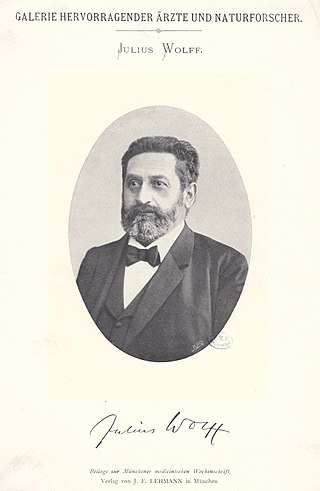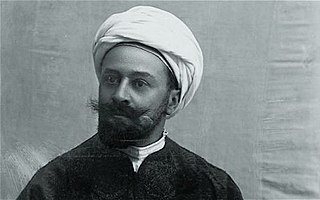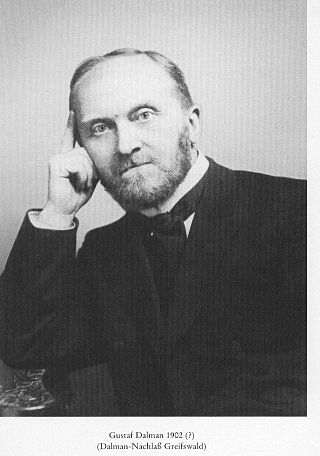
Julius Wolff was a German surgeon.

Tell Halaf is an archaeological site in the Al Hasakah governorate of northeastern Syria, a few kilometers from the city of Ras al-Ayn near the Syria–Turkey border. The site, which dates to the sixth millennium BCE, was the first to be excavated from a Neolithic culture, later called the Halaf culture, characterized by glazed pottery painted with geometric and animal designs.

Tell Fekheriye is an ancient site in the Khabur river basin in al-Hasakah Governorate of northern Syria. It is securely identified as the site of Sikkan, attested since c. 2000 BC. While under an Assyrian governor c. 1000 BC it was called Sikani. Sikkan was part of the Syro-Hittite state of Bit Bahiani in the early 1st millennium BC. In the area, several mounds, called tells, can be found in close proximity: Tell Fekheriye, Ras al-Ayn, and 2.5 kilometers east of Tell Halaf, site of the Aramean and Neo-Assyrian city of Guzana. During the excavation, the Tell Fekheriye bilingual inscription was discovered at the site, which provides the source of information about Hadad-yith'i.

Louis Kugelmann, or Ludwig Kugelmann, was a German gynecologist, social democratic thinker and activist, and confidant of Marx and Engels.

Baron Max von Oppenheim was a German lawyer, diplomat, ancient historian, and archaeologist. He was a member of the Oppenheim banking dynasty. Abandoning his career in diplomacy, he discovered the site of Tell Halaf in 1899 and conducted excavations there in 1911–13 and again in 1927–29. Bringing many of his finds to Berlin, he exhibited them in a private museum in 1931. This was destroyed by Allied bombing in World War II. However, most of the findings were recently restored and have been exhibited again at Berlin and Bonn.
Alfred Karl Gabriel Jeremias was a German pastor, Assyriologist and an expert on the religions of the ancient Near East.
Heidegger Gesamtausgabe is the title of the collected writings of German philosopher Martin Heidegger (1889-1976), published by Vittorio Klostermann.

Gustaf Hermann Dalman was a German Lutheran theologian and orientalist. He did extensive field work in Palestine before the First World War, collecting inscriptions, poetry, and proverbs. He also collected physical articles illustrative of the life of the indigenous farmers and herders of the country, including rock and plant samples, house and farm tools, small archaeological finds, and ceramics. He pioneered the study of biblical and early post-biblical Aramaic, publishing an authoritative grammar (1894) and dictionary (1901), as well as other works. His collection of 15,000 historic photographs and 5,000 books, including rare 16th century prints, and maps formed the basis of the Gustaf Dalman Institute at the Ernst Moritz Arndt University, Greifswald, which commemorates and continues his work.
Friedrich Wilhelm Adolf Würzbach was a Nietzsche scholar, Nazi sympathiser and convinced propagandist. He was born in Berlin in the summer of 1886 to a Polish-Jewish mother and German-Protestant father, and died in 1961 in Munich.
Die Deutschen Inschriften des Mittelalters und der Frühen Neuzeit (DI) is one of the oldest modern endeavours to collect and redact medieval and early modern inscriptions in Europe. The project was instituted by the German linguist Friedrich Panzer (Heidelberg) in association with the historians Karl Brandi (Göttingen) and Hans Hirsch (Vienna) as an interacademic venture of epigraphical publication in 1934. Encompassed are inscriptions ranging from the Early Middle Ages to the year of 1650 localized in the areas that are today known as the Federal Republic of Germany, the Republic of Austria and South Tyrol. By now the epigraphical research centers involved have published 81 volumes. An individual volume contains usually the inscriptions of a single city or Landkreis respectively called Politischer Bezirk in Austria. The venture is supported by the German Academies of Sciences in Berlin, Düsseldorf, Göttingen, Heidelberg, Leipzig, Mainz and München as well as the Austrian Academy of Sciences in Vienna. The Reichert-Verlag is the publishing house of the scientific editions.
Karin Anna Reich is a German historian of mathematics.
Fred K. Prieberg was a German musicologist. He was a pioneer in the field of history of music and musicians under the Nazi regime.
Helmuth Osthoff was a German musicologist and composer. Much of his career was spent at Frankfurt University, prior to which he held posts at Halle University and Berlin University. He wrote the first major biography on the composer Josquin des Prez, published as a two volume monograph in 1962 and 1965

The Canaanite and Aramaic inscriptions, also known as Northwest Semitic inscriptions, are the primary extra-Biblical source for understanding of the society and history of the ancient Phoenicians, Hebrews and Arameans. Semitic inscriptions may occur on stone slabs, pottery ostraca, ornaments, and range from simple names to full texts. The older inscriptions form a Canaanite–Aramaic dialect continuum, exemplified by writings which scholars have struggled to fit into either category, such as the Stele of Zakkur and the Deir Alla Inscription.

Friedrich Luft was a German feuilletonist and theater critic.
Mandaic lead rolls, sometimes also known as Mandaic amulets or sheets, which are related to Palestinian and Syrian metal amulets, are a specific term for a writing medium containing incantations in the Mandaic script incised onto lead sheets with a pin. Some Mandaic incantations are found on gold and silver sheets. They are rolled up and then inserted into a metal capsule with loops on it to be worn around the neck on a string or necklace.
The Aramaic Uruk incantation acquired 1913 by the Louvre, Paris and stored there under AO 6489 is a unique Aramaic text written in Late Babylonian cuneiform syllable signs and dates to the Seleucid Empire ca. 150 BCE. The finding site is the reš-sanctuary in the ancient city of Uruk (Warka), therefore the label “Uruk”. Particular about this incantation text is that it contains a magical historiola which is divided up into two nearly repetitive successive parts, a text genre that finds its continuation in the Aramaic magical text corpus of late antiquity from Iraq and Iran, most prominently in incantation bowls and Mandaic lead rolls.
The Athenian Greek-Phoenician inscriptions are 18 ancient Phoenician inscriptions found in the region of Athens, Greece. They represent the second largest group of foreign inscriptions in the region after the Thracians. 9 of the inscriptions are bilingual Phoenician-Greek and written on steles. Almost all of them bear the indication of the deceased's city of origin, not just the more general designation of their ethnicity, like most other non-Greek inscriptions in the region.

The County of Steinfurt, originally the Lordship of Steinfurt, was a historic territory of the Holy Roman Empire in the Munsterland. It existed from roughly 1100 until 1806.









